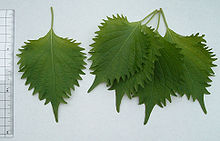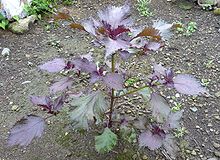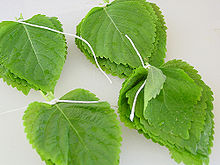- Perilla
-
This article is about the plant genus. For other uses, see Perilla (disambiguation).
Perilla 
Green shiso perilla Scientific classification Kingdom: Plantae (unranked): Angiosperms (unranked): Eudicots (unranked): Asterids Order: Lamiales Family: Lamiaceae Genus: Perilla
L.Perilla is the common name of the herbs of the genus Perilla of the mint family, Lamiaceae. In mild climates, the plant reseeds itself. There are both green-leafed and purple-leafed varieties, which are generally recognized as separate species by botanists. The leaves resemble stinging nettle leaves, but are slightly rounder in shape. Its essential oils provide for a strong taste whose intensity might be compared to that of mint or fennel. It is considered rich in minerals and vitamins, has anti-inflammatory properties, and is thought to help preserve and sterilize other foods. Like basil and coleus, it is a member of the mint family.
Contents
Ecology and naturalization
Perilla frutescens has been widely naturalized in the United States and part of Canada, from Texas and Florida north to Connecticut and into Ontario, and west to Nebraska. It can be weedy or invasive in some of these regions.[1]
China
Perilla is called zisu (simplified Chinese: 紫苏; traditional Chinese: 紫蘇; pinyin: zǐ sū) in Chinese and is traditionally used in Chinese medicine, and has been shown to stimulate interferon activity[1] and thus, the body's immune system. It is used to ease the symptoms of the common cold. It is fried in oil with garlic or ginger in the wok, and eaten as a dish with meals.
Japan
The Japanese name for perilla is shiso (紫蘇). The Japanese call the green type aojiso (青紫蘇), aoba ("green leaf"), ōba (corruption of aoba) or aoshiso, and often eat it with sashimi (sliced raw fish) or cut into thin strips in salads, spaghetti, and meat and fish dishes. It is also used as a flavorful herb in a variety of dishes, even as a pizza topping (initially it was used in place of basil). In the summer of 2009, Pepsi Japan released a new seasonal flavored beverage, Pepsi Shiso. [2]
The purple type is called akajiso (赤紫蘇, red shiso), and is used to dye umeboshi (pickled ume) red or combined with ume paste in sushi to make umeshiso maki. It can also be used to make a sweet, red juice to enjoy during summer.
An inflorescence of shiso is called hojiso (ear shiso). Its young leaves and flower buds are used for pickling in Japan and Taiwan.
Korea
The plant's Korean name is deulkkae or tŭlkkae (들깨). The same word is also used when referring to its seed, which has many uses in Korean cuisine, just as the leaves (ggaennip, 깻잎) do. The literal translations of deulkkae ("wild sesame") and ggaennip ("sesame leaf") are in spite of perilla's not being closely related to sesame, and Korean cookbooks translated into English sometimes use these translations. Cans of pickled ggaennip can be found in Korean shops all over the world, with some ground red pepper between every two leaves in the can. The leaves' essential oils provide for their strong taste. Fresh leaves have an aroma reminiscent of apples and mint, and are eaten in salad dishes. The flavor is distinct from Japanese perilla, and the leaf appearance is different as well – larger, rounder, flatter, with a less serrated edge, and often a violet coloring on the reverse side. Perilla oil (deulgireum, 들기름) is extracted from the seeds; the cake can be used as animal food. Perilla oil has a rich taste and scent slightly resembling dark sesame oil (chamgireum, 참기름). Perilla seed can be cooked with meals, roasted, crushed to intensify its taste and/or mixed with sesame and salt.
Laos
The purple leaves, called pak maengda (ຜັກແມງດາ), are strong in fragrance, but not ruffled. Lao also used them for Lao rice vermicelli, kao phoon (ເຂົ້າປຸ້ນ), which is very similar to the Vietnamese bún. They are used as part of the dish for their fragrance.
Vietnam
Vietnamese cuisine uses a variety similar to the Japanese hojiso, but with greenish bronze on the top face and purple on the opposite face. The leaves are smaller and have a much stronger fragrance than hojiso. In Vietnamese, it is called tía tô, derived from the characters (紫蘇) whose standard pronunciation in Vietnamese is tử tô. It is usually eaten as a garnish in rice vermicelli dishes called bún and a number of stews and simmered dishes.
South Asia
 Silam plant in Panchkhal, Nepal
Silam plant in Panchkhal, Nepal
In Nepal, Kumaun and parts of India, it is called silam (सिलाम) and Bhangira. Its seeds are roasted and ground with salt, chillies and tomatoes to make a savoury dip/side dish or chutney.
Chemistry
The essential oil extracted from the leaves of perilla by steam distillation consists of a variety of chemical compounds, which may vary depending on species. The most abundant, comprising about 50–60% of the oil, is perillaldehyde which is most responsible for the aroma and taste of perilla. Other terpenes, such as limonene, caryophyllene, and farnesene, are common, as well.
Of the known chemotypes of perilla, PA (main component: perillaldehyde) is the only one used for culinary purposes. Other chemotypes are PK (perilla ketone), EK (elsholzia ketone), PL (perillene), PP (phenylpropanoids: myristicin, dillapiole, elemicin), C (citral) and a type rich in rosefuran.
Perilla ketone is toxic to some animals. When cattle and horses consume purple mint (of the PK chemotype) while grazing in fields in which it grows, the perilla ketone causes pulmonary edema, leading to a condition sometimes called perilla mint toxicosis.
Perilla oil is obtained by pressing the seeds of perilla, which contain 35 to 45% oil. In parts of Asia, perilla oil used as an edible oil is valued more for its medicinal benefit than its flavor. Perilla oil is a very rich source of the omega-3 fatty acid alpha-linolenic acid. As a drying oil similar to tung oil or linseed oil, perilla oil has been used for paints, varnishes, linoleum, printing ink, lacquers, and for protective waterproof coatings on cloth. Perilla oil can also be used for fuel.
The oxime of perillaldehyde (perillartin) is used as an artificial sweetener in Japan, as it is about 2,000 times sweeter than sucrose.
See also
References
- He-ci Yu. "Perilla: The Genus Perilla". Medicinal & Aromatic Plants, Industrial Profiles. ISBN 90-5702-171-4.
- David Brenner (1995). "Perilla". Purdue University NewCrop Fact Sheet. http://www.hort.purdue.edu/newcrop/cropfactsheets/perilla.pdf. Retrieved 2009-04-04.
- Gernot Katzer (September 19, 2006). "Perilla (Perilla frutescens) L. Britton". Spice Pages. http://www.uni-graz.at/~katzer/engl/Peri_fru.html. Retrieved 2006-11-17.
- "Perilla (Japanese, Vietnamese and Korean Shi-So, Zi Su, Beefsteak)". Evergreen Seeds. http://evergreenseeds.stores.yahoo.net/perjapshis.html. Retrieved 2006-11-17. Commercial seed house with pictures of different perilla varieties
Categories:- Herbs
- Japanese ingredients
- Korean ingredients
- Lamiaceae
- Medicinal plants
- Vietnamese ingredients
Wikimedia Foundation. 2010.



